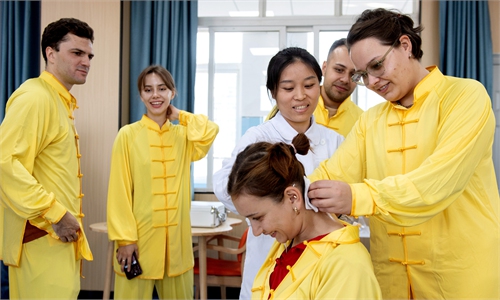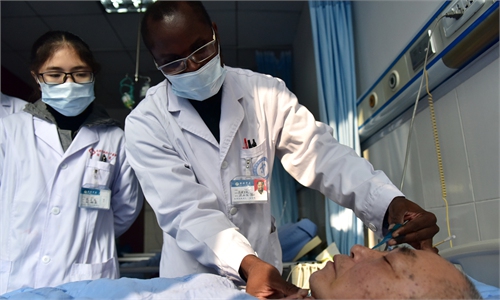IN-DEPTH / IN-DEPTH
Experiencing TCM craze at China-Kazakhstan Traditional Medicine Center

A Kazakh boy experiences massage therapy at the China-Kazakhstan Traditional Medicine Center in Astana, on June 12, 2025. Photo: Hu Yuwei/GT
As I stepped into the China-Kazakhstan Traditional Medicine Center in Astana, I was greeted by a bustling scene. The center was packed, with every bed occupied by patients undergoing various therapies.
A 5-year-old patient cheerfully said "Ni Hao" (Hello) to me in Chinese, casually scrolling through short videos while a Chinese doctor skillfully performed a therapeutic massage. Nearby, a young man, fresh from a cupping session, proudly pointed to the faint marks on his back, grinning, "I've got my 'fire stamps' from a Chinese doctor - light marks mean I'm healthy!"
This lively atmosphere is a daily occurrence at the center, a collaboration between the Xi'an TCM Hospital of Encephalopathy, the Shaanxi Provincial Hospital of Traditional Chinese Medicine in China and the Xi'an International TCM Treatment Center in Kazakhstan, established in Astana in December 2022. To date, it has served more than 38,000 patients.
"TCM acts as a bridge, connecting the hearts of Chinese and Kazakh people. In the past three months, we've seen at least 25 patients daily," said Ismail Daurov, a Kazakh doctor and therapist at the center who were trained at the Shaanxi University of Chinese Medicine. "Whether 'traditional' or 'foreign' practitioners, we are ambassadors spreading TCM culture and advancing the Health Silk Road."
Daurov noted that as TCM techniques gain traction, colorful terms like "fire stamps," "painless long needles" and "sweet herbal tea" have caught on locally. Fun, effective and rooted in friendship, these elements have sparked a "TCM fever," making it a symbol of health and style.
Walking through Astana's streets, I spotted many clinics with TCM signs. Locals told me the number of TCM therapy centers is steadily growing.
Gao Feng, the Chinese director at the center, told Global Times, "Kazakhs near the China-Kazakhstan border are more familiar with TCM. As its global reputation rises, more are intrigued, especially for conditions like autism, cerebral palsy in children, and stroke aftereffects."
"Winters here are brutally long, with temperatures dropping below -40 C, leaving people vulnerable to cold. With TCM moxibustion and massage, they feel instant relief, which builds confidence in the treatment. Word-of-mouth drives this - people come back because it works," Gao explained.
Media reports highlight TCM's rapid growth in Kazakhstan, with dozens of acupuncture and massage clinics in Astana alone. Since the visa-free agreement reached between China and Kazakhstan in November 2024, travel for medical treatment has become easier. Under the Belt and Road Initiative, as ties deepen, TCM's influence in Kazakhstan is set to grow.
Daurov pointed out that Kazakhstan's diverse geography yields rich natural resources, and locals have long used herbal remedies - a tradition mirroring China's TCM. "This similarity helps TCM gain acceptance here, with hundreds of medicinal plants identified locally."
Gao added that many patients trust Chinese doctors' faces upon entering. Though there may be a language barrier, trust never falters. The relaxed brows and serene expressions in the wards tell a story beyond medicine - a modern echo of the ancient Silk Road bond.




